Dogs are natural-born movers, chasers, and explorers. It’s in their DNA to run, sniff, tug, and leap. But while most dog owners understand that exercise is important, few realize just how essential it is to a dog’s overall well-being. Not only does physical activity maintain a healthy weight and strengthen muscles, but it also supports mental health, curbs destructive behavior, and deepens the bond between dog and owner. When exercise becomes more than just a daily walk around the block and turns into a tailored, purposeful activity, dogs thrive—and so do their humans.
Understanding What Exercise Really Means for Dogs
The word “exercise” may conjure up images of jogs or backyard games of fetch, but for dogs, a true workout goes far beyond that. Exercise should be both physical and mental. Physical activity strengthens the body, but dogs also need to be challenged intellectually to feel fulfilled. A bored dog is an unhappy dog, and under-stimulated pets often act out with behaviors like chewing furniture, barking excessively, or digging up the yard. Integrating a variety of exercises—ones that cater to breed, age, and temperament—creates a balanced routine that leads to a healthier, calmer, and more content dog.
Matching Activities to Your Dog’s Breed and Energy Level
Not all dogs are created equal when it comes to exercise needs. A Border Collie thrives with tasks that require problem-solving and movement, while a French Bulldog may prefer shorter, slower walks and simple indoor games. Tailoring your dog’s exercise routine based on their breed and individual energy level is critical. High-energy dogs like Labrador Retrievers or Australian Shepherds may need two hours or more of exercise per day, including running, agility drills, or swimming. In contrast, lower-energy breeds might only need 30 to 45 minutes, with plenty of rest breaks.
Knowing your dog’s limitations is just as important as knowing their potential. Senior dogs or those with joint issues may benefit from lower-impact activities like swimming or walking on soft terrain. Puppies, while full of energy, still have growing bones and should avoid overexertion. Exercise should challenge your dog but never exhaust or harm them.
Making Exercise a Mental Workout Too
Mental stimulation is often overlooked but is just as vital as physical exercise. Dogs are intelligent, curious animals that need to use their brains to stay happy. One way to achieve this is by turning physical play into games of strategy or scent work. Hide-and-seek, food puzzles, and treat treasure hunts are excellent ways to get your dog moving while also engaging their mind.
Agility courses—whether in your backyard or at a training facility—combine the benefits of mental and physical stimulation. Navigating tunnels, jumping through hoops, and weaving through poles keeps your dog sharp and active. Teaching new tricks or commands is another great form of mental exercise, and it reinforces obedience while boosting confidence. When your dog works their mind, even short sessions can be incredibly tiring in the best way.
Incorporating Exercise into Everyday Life
Making dog exercise part of your daily rhythm doesn’t have to be a chore. It can be woven naturally into your schedule. Take the stairs instead of the elevator, play tug-of-war during commercial breaks, or bring your dog along on errands that involve walking. Even ten-minute bursts of activity throughout the day can add up to a big difference in your dog’s health.
One often overlooked opportunity is social exercise. Dog parks and doggy daycare provide physical outlet and social interaction. Playing with other dogs builds social skills and can burn off more energy than a simple walk. Just make sure to supervise playtime and ensure it remains positive and safe.
For pet parents with busy schedules, setting a consistent exercise routine helps keep both you and your dog on track. Early morning or evening walks, regular weekend hikes, or weekly playdates at the park become something you both look forward to—and your dog will quickly remind you when it’s time to go.
Signs Your Dog Needs More—or Less—Exercise
Dogs can’t always tell us when something is off, but they do communicate through behavior. A dog with pent-up energy might bark excessively, dig, chew things, or seem overly hyper. These are clear signs that your pup needs more stimulation. On the flip side, if your dog seems lethargic, reluctant to move, or is limping, they might be getting too much exercise or need a change in routine.
Pay attention to how your dog behaves before and after activity. They should be energized but not frantic, tired but not sore. As with humans, balance is key. If you’re ever unsure, consult your vet or a professional dog trainer who can help develop an ideal exercise regimen for your dog’s age, breed, and health status.
The Long-Term Benefits of Consistent, Purposeful Exercise
When dogs get the right type and amount of exercise, the benefits reach far beyond physical health. They’re less anxious, more obedient, and more content in their environment. Exercise reduces stress and builds trust between dog and owner. It also gives you insight into your dog’s personality—how they play, what excites them, and what makes them feel safe.
As dogs age, an active lifestyle can help delay the onset of arthritis, obesity, and other age-related issues. Regular movement keeps joints limber, maintains a healthy metabolism, and supports cardiovascular function. And most importantly, it keeps your dog happy. Happy dogs live longer, and they enjoy those years with a wagging tail and bright eyes.
Final Thoughts: Move with Intention, Play with Purpose
Exercise isn’t just about tiring your dog out—it’s about enriching their life. Turning movement into a meaningful, mentally engaging activity transforms a dog’s behavior and deepens your relationship with them. Whether it’s a new trick, a run on the beach, or a puzzle game after dinner, what matters most is being present and intentional with your time together.
Dogs give us their loyalty, love, and playful spirit. The least we can do is return the favor with daily moments that move their bodies and inspire their minds. So grab that leash, toss the frisbee, or set up a mini agility course in your yard. Your dog’s health—and happiness—depends on it.







